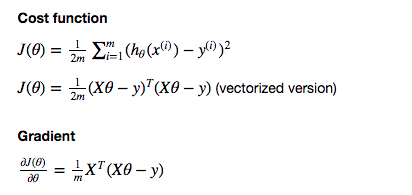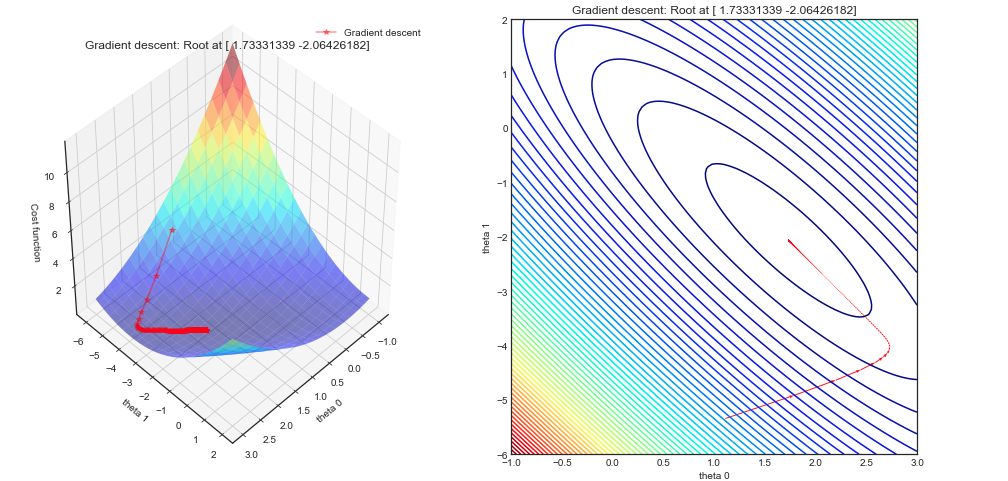As a self study exercise I am trying to implement gradient descent on a linear regression problem from scratch and plot the resulting iterations on a contour plot.
My gradient descent implementation gives the correct result (tested with Sklearn) however the gradient descent plot doesn't seem to be perpendicular to the contour lines. Is this expected or did I get something wrong in my code / understanding?
Algorithm
Cost function and gradient descent
import numpy as np
import pandas as pd
from matplotlib import pyplot as plt
from mpl_toolkits.mplot3d import Axes3D
def costfunction(X,y,theta):
m = np.size(y)
#Cost function in vectorized form
h = X @ theta
J = float((1./(2*m)) * (h - y).T @ (h - y));
return J;
def gradient_descent(X,y,theta,alpha = 0.0005,num_iters=1000):
#Initialisation of useful values
m = np.size(y)
J_history = np.zeros(num_iters)
theta_0_hist, theta_1_hist = [], [] #For plotting afterwards
for i in range(num_iters):
#Grad function in vectorized form
h = X @ theta
theta = theta - alpha * (1/m)* (X.T @ (h-y))
#Cost and intermediate values for each iteration
J_history[i] = costfunction(X,y,theta)
theta_0_hist.append(theta[0,0])
theta_1_hist.append(theta[1,0])
return theta,J_history, theta_0_hist, theta_1_hist
Plot
#Creating the dataset (as previously)
x = np.linspace(0,1,40)
noise = 1*np.random.uniform( size = 40)
y = np.sin(x * 1.5 * np.pi )
y_noise = (y + noise).reshape(-1,1)
X = np.vstack((np.ones(len(x)),x)).T
#Setup of meshgrid of theta values
T0, T1 = np.meshgrid(np.linspace(-1,3,100),np.linspace(-6,2,100))
#Computing the cost function for each theta combination
zs = np.array( [costfunction(X, y_noise.reshape(-1,1),np.array([t0,t1]).reshape(-1,1))
for t0, t1 in zip(np.ravel(T0), np.ravel(T1)) ] )
#Reshaping the cost values
Z = zs.reshape(T0.shape)
#Computing the gradient descent
theta_result,J_history, theta_0, theta_1 = gradient_descent(X,y_noise,np.array([0,-6]).reshape(-1,1),alpha = 0.3,num_iters=1000)
#Angles needed for quiver plot
anglesx = np.array(theta_0)[1:] - np.array(theta_0)[:-1]
anglesy = np.array(theta_1)[1:] - np.array(theta_1)[:-1]
%matplotlib inline
fig = plt.figure(figsize = (16,8))
#Surface plot
ax = fig.add_subplot(1, 2, 1, projection='3d')
ax.plot_surface(T0, T1, Z, rstride = 5, cstride = 5, cmap = 'jet', alpha=0.5)
ax.plot(theta_0,theta_1,J_history, marker = '*', color = 'r', alpha = .4, label = 'Gradient descent')
ax.set_xlabel('theta 0')
ax.set_ylabel('theta 1')
ax.set_zlabel('Cost function')
ax.set_title('Gradient descent: Root at {}'.format(theta_result.ravel()))
ax.view_init(45, 45)
#Contour plot
ax = fig.add_subplot(1, 2, 2)
ax.contour(T0, T1, Z, 70, cmap = 'jet')
ax.quiver(theta_0[:-1], theta_1[:-1], anglesx, anglesy, scale_units = 'xy', angles = 'xy', scale = 1, color = 'r', alpha = .9)
plt.show()
Surface and contour plots
Comments
My understanding is that the gradient descent follow contour lines perpendicularly. Is this not the case ? Thanks


